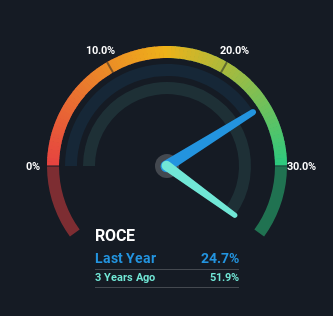- India
- /
- Trade Distributors
- /
- NSEI:VINYLINDIA
Some Investors May Be Worried About Vinyl Chemicals (India)'s (NSE:VINYLINDIA) Returns On Capital

If we want to find a stock that could multiply over the long term, what are the underlying trends we should look for? Ideally, a business will show two trends; firstly a growing return on capital employed (ROCE) and secondly, an increasing amount of capital employed. This shows us that it's a compounding machine, able to continually reinvest its earnings back into the business and generate higher returns. Looking at Vinyl Chemicals (India) (NSE:VINYLINDIA), it does have a high ROCE right now, but lets see how returns are trending.
What Is Return On Capital Employed (ROCE)?
If you haven't worked with ROCE before, it measures the 'return' (pre-tax profit) a company generates from capital employed in its business. The formula for this calculation on Vinyl Chemicals (India) is:
Return on Capital Employed = Earnings Before Interest and Tax (EBIT) ÷ (Total Assets - Current Liabilities)
0.25 = ₹285m ÷ (₹2.3b - ₹1.2b) (Based on the trailing twelve months to December 2024).
Thus, Vinyl Chemicals (India) has an ROCE of 25%. In absolute terms that's a great return and it's even better than the Trade Distributors industry average of 6.1%.
Check out our latest analysis for Vinyl Chemicals (India)

Historical performance is a great place to start when researching a stock so above you can see the gauge for Vinyl Chemicals (India)'s ROCE against it's prior returns. If you're interested in investigating Vinyl Chemicals (India)'s past further, check out this free graph covering Vinyl Chemicals (India)'s past earnings, revenue and cash flow.
How Are Returns Trending?
In terms of Vinyl Chemicals (India)'s historical ROCE movements, the trend isn't fantastic. Historically returns on capital were even higher at 35%, but they have dropped over the last five years. However, given capital employed and revenue have both increased it appears that the business is currently pursuing growth, at the consequence of short term returns. If these investments prove successful, this can bode very well for long term stock performance.
On a related note, Vinyl Chemicals (India) has decreased its current liabilities to 51% of total assets. That could partly explain why the ROCE has dropped. What's more, this can reduce some aspects of risk to the business because now the company's suppliers or short-term creditors are funding less of its operations. Since the business is basically funding more of its operations with it's own money, you could argue this has made the business less efficient at generating ROCE. Keep in mind 51% is still pretty high, so those risks are still somewhat prevalent.
The Bottom Line
In summary, despite lower returns in the short term, we're encouraged to see that Vinyl Chemicals (India) is reinvesting for growth and has higher sales as a result. And the stock has done incredibly well with a 366% return over the last five years, so long term investors are no doubt ecstatic with that result. So while the underlying trends could already be accounted for by investors, we still think this stock is worth looking into further.
Vinyl Chemicals (India) does have some risks though, and we've spotted 2 warning signs for Vinyl Chemicals (India) that you might be interested in.
High returns are a key ingredient to strong performance, so check out our free list ofstocks earning high returns on equity with solid balance sheets.
If you're looking to trade Vinyl Chemicals (India), open an account with the lowest-cost platform trusted by professionals, Interactive Brokers.
With clients in over 200 countries and territories, and access to 160 markets, IBKR lets you trade stocks, options, futures, forex, bonds and funds from a single integrated account.
Enjoy no hidden fees, no account minimums, and FX conversion rates as low as 0.03%, far better than what most brokers offer.
Sponsored ContentNew: Manage All Your Stock Portfolios in One Place
We've created the ultimate portfolio companion for stock investors, and it's free.
• Connect an unlimited number of Portfolios and see your total in one currency
• Be alerted to new Warning Signs or Risks via email or mobile
• Track the Fair Value of your stocks
Have feedback on this article? Concerned about the content? Get in touch with us directly. Alternatively, email editorial-team (at) simplywallst.com.
This article by Simply Wall St is general in nature. We provide commentary based on historical data and analyst forecasts only using an unbiased methodology and our articles are not intended to be financial advice. It does not constitute a recommendation to buy or sell any stock, and does not take account of your objectives, or your financial situation. We aim to bring you long-term focused analysis driven by fundamental data. Note that our analysis may not factor in the latest price-sensitive company announcements or qualitative material. Simply Wall St has no position in any stocks mentioned.
About NSEI:VINYLINDIA
Flawless balance sheet established dividend payer.
Similar Companies
Market Insights
Community Narratives




